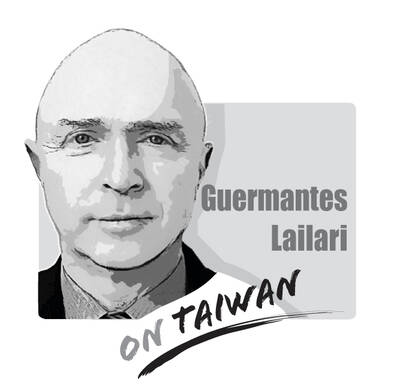During his visit to the US, Chinese Nationalist Party (KMT) Chairman Eric Chu (朱立倫) said that the KMT is a pro-US party that has always fought against communism, and that the “1992 consensus” is a “consensus without a consensus” for the sake of “creative ambiguity.”
When trying to persuade others of his “pro-US, anti-China” stance, Chu’s intended audience was actually inside the KMT, not the people he was speaking to in the US.
After all, it is nothing new for certain individuals in the pan-blue camp to repeatedly and publicly express their doubts about Washington or their support for Beijing.
In January 2019, I once showed my opposition to the “1992 consensus” as a serving diplomat, when the issue was widely discussed. The main reason for my opposition was that, as a professional diplomat, I should not keep sending the wrong message to the international community.
If the “1992 consensus” does not exist at all, or if it is a so-called “pseudo-tacit agreement” without any factual or legal basis, then it is better to recognize the reality as soon as possible, instead of “drinking poison to quench one’s thirst,” as the old Chinese saying goes.
The greatest damage the “1992 consensus” inflicts on Taiwan is that it misleads the international community into believing that China has ultimate power over Taiwan’s participation in global institutions.
During former president Ma Ying-jeou’s (馬英九) eight-year tenure, Taiwan was able to participate as an observer in the World Health Assembly, the International Civil Aviation Organization and the UN Framework Convention on Climate Change, but Taiwan’s inclusion was all at the mercy of Beijing.
Such international participation at that time, to a degree, reinforced a misperception of Taiwan’s subordination to China. This was no reason for celebration, and in fact made many sigh, yet the Ma administration took it as a “diplomatic achievement” and was content with itself.
Since President Tsai Ing-wen (蔡英文) took office in 2016, the negative consequences of the “1992 consensus” to Taiwan’s diplomatic efforts have gradually emerged.
The authorities of those international organizations certainly have no doubt about what contribution Taiwan can make. Unfortunately, they continue to follow the will of Chinese President Xi Jinping (習近平).
The “1992 consensus” carries no legal weight in international law. It does not even exist in any official documents jointly recognized by both sides of the Taiwan Strait, and there is certainly no written version of the “1992 consensus” jointly recognized by Taiwan and China. So exactly what does “a consensus without a consensus” mean?
Perhaps Taiwan can learn a lesson from the 1984 Sino-British Joint Declaration. Signed by then-Chinese premier Zhao Ziyang (趙紫陽) and then-British prime minister Margaret Thatcher, the declaration was approved by the two countries and registered at the UN.
However, this international document, which was crucial to the fate of Hong Kong, was later redefined by the Chinese government as a historical document without any significance, and this is how the Chinese side now views it.
I would like to ask Chu: What kind of protection can the empty words of the “1992 consensus,” based on respective interpretations, bring to Taiwan?
It is not a creative ambiguity, but a destructive constraint. As Chu traveled thousands of miles just to play the old tune again, did his remarks please Washington or make it sigh?
Jerry Liu is the director of the New Power Party’s international division.
Translated by Eddy Chang

Chinese state-owned companies COSCO Shipping Corporation and China Merchants have a 30 percent stake in Kaohsiung Port’s Kao Ming Container Terminal (Terminal No. 6) and COSCO leases Berths 65 and 66. It is extremely dangerous to allow Chinese companies or state-owned companies to operate critical infrastructure. Deterrence theorists are familiar with the concepts of deterrence “by punishment” and “by denial.” Deterrence by punishment threatens an aggressor with prohibitive costs (like retaliation or sanctions) that outweigh the benefits of their action, while deterrence by denial aims to make an attack so difficult that it becomes pointless. Elbridge Colby, currently serving as the Under
The Ministry of the Interior on Thursday last week said it ordered Internet service providers to block access to Chinese social media platform Xiaohongshu (小紅書, also known as RedNote in English) for a year, citing security risks and more than 1,700 alleged fraud cases on the platform since last year. The order took effect immediately, abruptly affecting more than 3 million users in Taiwan, and sparked discussions among politicians, online influencers and the public. The platform is often described as China’s version of Instagram or Pinterest, combining visual social media with e-commerce, and its users are predominantly young urban women,
Most Hong Kongers ignored the elections for its Legislative Council (LegCo) in 2021 and did so once again on Sunday. Unlike in 2021, moderate democrats who pledged their allegiance to Beijing were absent from the ballots this year. The electoral system overhaul is apparent revenge by Beijing for the democracy movement. On Sunday, the Hong Kong “patriots-only” election of the LegCo had a record-low turnout in the five geographical constituencies, with only 1.3 million people casting their ballots on the only seats that most Hong Kongers are eligible to vote for. Blank and invalid votes were up 50 percent from the previous
Japanese Prime Minister Sanae Takaichi lit a fuse the moment she declared that trouble for Taiwan means trouble for Japan. Beijing roared, Tokyo braced and like a plot twist nobody expected that early in the story, US President Donald Trump suddenly picked up the phone to talk to her. For a man who normally prefers to keep Asia guessing, the move itself was striking. What followed was even more intriguing. No one outside the room knows the exact phrasing, the tone or the diplomatic eyebrow raises exchanged, but the broad takeaway circulating among people familiar with the call was this: Trump did